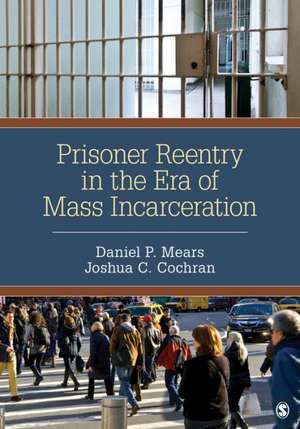Prisoner Reentry in the Era of Mass Incarceration
Autor Daniel P. Mears, Joshua C. Cochranen Limba Engleză Paperback – 23 feb 2015
Preț: 481.87 lei
Nou
Puncte Express: 723
Preț estimativ în valută:
92.23€ • 100.22$ • 77.53£
92.23€ • 100.22$ • 77.53£
Carte tipărită la comandă
Livrare economică 22 aprilie-06 mai
Preluare comenzi: 021 569.72.76
Specificații
ISBN-13: 9781483316727
ISBN-10: 1483316726
Pagini: 344
Dimensiuni: 178 x 254 x 20 mm
Greutate: 0.59 kg
Ediția:1
Editura: SAGE Publications
Colecția Sage Publications, Inc
Locul publicării:Thousand Oaks, United States
ISBN-10: 1483316726
Pagini: 344
Dimensiuni: 178 x 254 x 20 mm
Greutate: 0.59 kg
Ediția:1
Editura: SAGE Publications
Colecția Sage Publications, Inc
Locul publicării:Thousand Oaks, United States
Recenzii
"Mass imprisonment and mass prisoner reentry are two faces of the same coin. In a comprehensive and penetrating analysis, Daniel Mears and Joshua Cochran unravel the causes of this pressing problem, detail the challenges confronting released prisoners, and provide an evidence-based blueprint for successfully reintegrating offenders into the community. Scholarly yet accessible, this volume is essential reading—whether by academics or students—for anyone wishing to understand the chief policy issue facing American corrections."
"Mears and Cochran have produced a terrific book that is both comprehensive and accessible. By placing reentry in the particular American context of mass incarceration, they have made an important contribution to the contemporary debate about penal policy. If you only want to read one book about today’s American penal system and its challenges for reentry, read this one."
"In Prisoner Reentry in the Era of Mass Incarceration, Mears and Cochran confront the absurdity and human toll of America’s mass incarceration project and serve up provocative questions, serious scholarship, and clear-minded proposals for a new approach to reintegrating offenders into society. If we take seriously prisoner reentry, and we should, Mears and Cochran have given us the field manual."
“Excellent book. It is timely, current, cogent and the authors make compelling arguments. The authors do a fine job of putting into perspective the challenges of re-entry and debunking myths related to reintegration. I will highly recommend the book.”
“I like its comprehensive nature. Many of the observations offered bode well with the example and stories that I draw upon in class – many from my own experience.”
“My overall assessment of the text is that it is ‘outstanding’. The information is well organized, the content is exceptional and it is appropriate for undergraduate students.”
"Mears and Cochran have produced a terrific book that is both comprehensive and accessible. By placing reentry in the particular American context of mass incarceration, they have made an important contribution to the contemporary debate about penal policy. If you only want to read one book about today’s American penal system and its challenges for reentry, read this one."
"In Prisoner Reentry in the Era of Mass Incarceration, Mears and Cochran confront the absurdity and human toll of America’s mass incarceration project and serve up provocative questions, serious scholarship, and clear-minded proposals for a new approach to reintegrating offenders into society. If we take seriously prisoner reentry, and we should, Mears and Cochran have given us the field manual."
“Excellent book. It is timely, current, cogent and the authors make compelling arguments. The authors do a fine job of putting into perspective the challenges of re-entry and debunking myths related to reintegration. I will highly recommend the book.”
“I like its comprehensive nature. Many of the observations offered bode well with the example and stories that I draw upon in class – many from my own experience.”
“My overall assessment of the text is that it is ‘outstanding’. The information is well organized, the content is exceptional and it is appropriate for undergraduate students.”
Cuprins
Chapter 1: Introduction
Mass Incarceration and Reentry
The Goals of This Book
Criminological “Versus” Criminal Justice Theory and Research
Terminology and Scope
Organization of the Book
Chapter 2: Historical Trends in Corrections and Reentry Policy and Practice
Trends in Correctional Populations: The Era of Mass Corrections
Trends in Reentry Policy and Practice
The Theory, or Causal Logic, of the Punitive Turn in Sanctioning Convicted Felons
Implications of Historical Trends in Incarceration and Reentry Policy and Practice
Conclusion
Discussion Questions
Chapter 3: The Causes of Mass Incarceration and Thus Mass Reentry
Causal Complexity in Understanding the Punitive Turn
Cause 1: Not Crime
Cause 2: Public Demand for Increased Punitive Sanctioning
Cause 3: Conservatism, Race, Moral Panics, and the Politicization of Crime
Cause 4: Increased Belief in the Idea That Individual Responsibility Matters Most
Cause 5: Exaggerated Claims for Incarceration
Cause 6: Discounting Effectiveness of Non-Incarcerative Sanctions
Cause 7: Inadequate Research Documenting the Need for Specific Types of Sanctions
Cause 8: Economics
Cause 9. Systems-Level Forces and Dynamics
Causal Complexity Revisited
Conclusion, or Why Understanding the Punitive Turn Is Relevant for Reentry Policy
Discussion Questions
Chapter 4: Profile of the Inmate Population
Why Inmate and Ex-Prisoner Characteristics Matter
Inmate and Ex-Prisoner Characteristics
The “Typical Inmate” Profile
Why Inmate Profiles Change Over Time
Conclusion
Discussion Questions
Chapter 5: The Prison Experience
Why What Happens in Prison Is Relevant for Understanding Reentry
The Implications of In-Prison Crime and Misconduct
Prison Experiences that May Have Implications for Prisoner Reentry
How Inmates Perceive Themselves and the Prison Experience and Why It Matters
The (Lack of) Evidence on the Effectiveness of Incarceration
Concepts of What the Prison Experience Should Be
Making Greater Accountability Happen
Conclusion
Discussion Questions
Chapter 6: The Reentry Experience and Reentry Challenges
The Reentry Process and Experience
The Logic of “Invisible” Punishments and Their Consequences
Specific Challenges During Reentry
Implications of Reentry Challenges for Ex-Prisoners and Families and Communities
Conclusion
Discussion Questions
Chapter 7: Recidivism and Risk Prediction
The Atheoretical Foundation of Mass Incarceration
The A Priori, Theoretically Predictable Consequences of Incarceration
Recidivism Rates—A Depressing Problem
Risk Prediction Approaches
Risk Prediction Success
The Challenges of Risk Prediction
Approaches to Improve Risk Prediction
Shifting the Focus of Risk Prediction
Conclusion
Discussion Questions
Chapter 8: Diverse Inmate Populations and Reentry
The Diversity of the Inmate and Ex-Prisoner Population and Why It Matters
The Youngest Ex-Prisoners
Female Ex-Prisoners
Racial and Ethnic Minority Ex-Prisoners
Other Groups of Ex-Prisoners
Super-Maximum Security Ex-Prisoners
Drug-Abusing Ex-Prisoners
Mentally Ill or Learning Disabled Ex-Prisoners
Still Other Groups of Ex-Prisoners
Revisiting Sanctioning and Reentry
Conclusion
Discussion Questions
Chapter 9: Reentry Policy and What Works to Improve Reentry Outcomes
The Ineffectiveness of Incarceration in Improving Public Safety or Other Outcomes
The Ineffectiveness of Incarceration Due to Collateral Consequences
Corrections Efforts Frequently Rest on Weak Theoretical and Empirical Grounds
Minimal Evaluation of Most Reentry Policies, Programs, and Practices
Pre-Prison, In-Prison, and Postrelease Approaches to Successful Reentry
General Guidelines and Strategies for Improving Reentry
The Importance of Evidence of Cost-Efficiency, Not Just Impacts
The Need for an Offender, Victim, and Community Justice System
Reentry Lessons and Convicted Felons Who Don’t Go to Prison
The Importance of Government Accountability and Evidence-Based Practice
Conclusion
Discussion Questions
Chapter 10: Conclusion
Mass Incarceration and Reentry
The Goals of This Book
Criminological “Versus” Criminal Justice Theory and Research
Terminology and Scope
Organization of the Book
Chapter 2: Historical Trends in Corrections and Reentry Policy and Practice
Trends in Correctional Populations: The Era of Mass Corrections
Trends in Reentry Policy and Practice
The Theory, or Causal Logic, of the Punitive Turn in Sanctioning Convicted Felons
Implications of Historical Trends in Incarceration and Reentry Policy and Practice
Conclusion
Discussion Questions
Chapter 3: The Causes of Mass Incarceration and Thus Mass Reentry
Causal Complexity in Understanding the Punitive Turn
Cause 1: Not Crime
Cause 2: Public Demand for Increased Punitive Sanctioning
Cause 3: Conservatism, Race, Moral Panics, and the Politicization of Crime
Cause 4: Increased Belief in the Idea That Individual Responsibility Matters Most
Cause 5: Exaggerated Claims for Incarceration
Cause 6: Discounting Effectiveness of Non-Incarcerative Sanctions
Cause 7: Inadequate Research Documenting the Need for Specific Types of Sanctions
Cause 8: Economics
Cause 9. Systems-Level Forces and Dynamics
Causal Complexity Revisited
Conclusion, or Why Understanding the Punitive Turn Is Relevant for Reentry Policy
Discussion Questions
Chapter 4: Profile of the Inmate Population
Why Inmate and Ex-Prisoner Characteristics Matter
Inmate and Ex-Prisoner Characteristics
The “Typical Inmate” Profile
Why Inmate Profiles Change Over Time
Conclusion
Discussion Questions
Chapter 5: The Prison Experience
Why What Happens in Prison Is Relevant for Understanding Reentry
The Implications of In-Prison Crime and Misconduct
Prison Experiences that May Have Implications for Prisoner Reentry
How Inmates Perceive Themselves and the Prison Experience and Why It Matters
The (Lack of) Evidence on the Effectiveness of Incarceration
Concepts of What the Prison Experience Should Be
Making Greater Accountability Happen
Conclusion
Discussion Questions
Chapter 6: The Reentry Experience and Reentry Challenges
The Reentry Process and Experience
The Logic of “Invisible” Punishments and Their Consequences
Specific Challenges During Reentry
Implications of Reentry Challenges for Ex-Prisoners and Families and Communities
Conclusion
Discussion Questions
Chapter 7: Recidivism and Risk Prediction
The Atheoretical Foundation of Mass Incarceration
The A Priori, Theoretically Predictable Consequences of Incarceration
Recidivism Rates—A Depressing Problem
Risk Prediction Approaches
Risk Prediction Success
The Challenges of Risk Prediction
Approaches to Improve Risk Prediction
Shifting the Focus of Risk Prediction
Conclusion
Discussion Questions
Chapter 8: Diverse Inmate Populations and Reentry
The Diversity of the Inmate and Ex-Prisoner Population and Why It Matters
The Youngest Ex-Prisoners
Female Ex-Prisoners
Racial and Ethnic Minority Ex-Prisoners
Other Groups of Ex-Prisoners
Super-Maximum Security Ex-Prisoners
Drug-Abusing Ex-Prisoners
Mentally Ill or Learning Disabled Ex-Prisoners
Still Other Groups of Ex-Prisoners
Revisiting Sanctioning and Reentry
Conclusion
Discussion Questions
Chapter 9: Reentry Policy and What Works to Improve Reentry Outcomes
The Ineffectiveness of Incarceration in Improving Public Safety or Other Outcomes
The Ineffectiveness of Incarceration Due to Collateral Consequences
Corrections Efforts Frequently Rest on Weak Theoretical and Empirical Grounds
Minimal Evaluation of Most Reentry Policies, Programs, and Practices
Pre-Prison, In-Prison, and Postrelease Approaches to Successful Reentry
General Guidelines and Strategies for Improving Reentry
The Importance of Evidence of Cost-Efficiency, Not Just Impacts
The Need for an Offender, Victim, and Community Justice System
Reentry Lessons and Convicted Felons Who Don’t Go to Prison
The Importance of Government Accountability and Evidence-Based Practice
Conclusion
Discussion Questions
Chapter 10: Conclusion
Notă biografică
Descriere
This is an engaging examination of prisoner re-entry and how to improve public safety, well-being, and justice in the “era of mass incarceration.”







